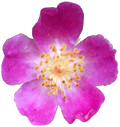Making Your Own Apple Pectin
By Sam Thayer
From The Forager. Volume 1, Issue 3. August-September 2001
When making homemade jams and jellies, commercial powdered pectin is usually the most expensive ingredient. A few generations ago, powdered pectin wasn't readily available, and the skill of making pectin at home was common knowledge for the family cook - yet today it is a rare individual who knows how to do this. I learned how to extract pectin from apples a few years ago when I made jams and jellies for a living (as many as 600 jars per day). Not only does this save money, but more importantly, it provides the satisfaction that only comes with doing things from scratch - one of the reasons that I love using wild foods.
To prepare liquid apple pectin, it is best to use under-ripe apples that are still a bit green, hard, and sour. Ripe apples contain less pectin, but the level varies greatly from one tree to the next; some varieties are suitable when ripe, while some have virtually no pectin by that time. Over-ripe apples are the worst. You can use your damaged or misshapen apples for making pectin. Chop them in halves or quarters, fill a large pot, and then add just enough water to almost cover the apple chunks. Cover the pot and place it on low heat for a long time, until the apples are fully cooked and you have something that looks like runny applesauce with skins and seeds in it. Stir the apples every twenty minutes or so while they are cooking.
I arrange a strainer for this "sauce" by placing a cheese cloth (actually a white T-shirt) over the top of a five-gallon pail, secured by a cord tied around the rim. (A piece of cheese cloth in a colander works fine for smaller amounts.) The hot applesauce is then poured into the strainer; what drips out the bottom should be a clear, thick liquid that's a little bit slimy to the touch. That's your liquid apple pectin. I usually let mine strain overnight, because it drips slowly. You can get more pectin by pressing it, but then it comes out a little cloudy and carries more of the under-ripe apple flavor. I like to make a few gallons of this pectin at a time and then save it by canning or freezing - it's not hard to get a year's supply with one batch.
To test the strength of the pectin, pour a little bit of rubbing alcohol into a glass and then drop in a spoonful of pectin. The pectin will coagulate into a jelly-like mass. If this mass can be pulled out with a fork and it forms a heaping gob on the tines, it is concentrated enough to jell perfectly. If it can be picked up by the fork, but mostly hangs from it, then it will jell loosely. If it cannot be picked up by the fork in mostly one mass, then the concentration is too weak for it to jell. In this latter case, you just have to boil it down to increase the concentration of the pectin. (Note: the alcohol test doesn't work right if the pectin is hot.)
You can mix liquid apple pectin with fruit or juice and boil it down until the mixture has enough pectin to jell. This can be a little tricky. If you mix it with a fruit juice such as chokecherry that has little or no natural pectin in it, you will want to boil this mixture down to approximately the same volume as that of the pectin that you put in. If you mix it with high-pectin fruit such as wild grapes, you might only have to boil it down a little. Boiling the fruit-pectin mixture will not harm the flavor unless it cooks to the bottom of the pan, which will not happen if you keep stirring it as it boils. (An overcooked or burnt flavor is generally the result of cooking the jam for too long only after the sugar has been added.) I like to use liquid pectin instead of water to cover fruits such as currants or wild cherries when I boil them to extract the juice. After boiling down a little bit, such juice often has enough pectin to jell. If it is cooled down, the pectin concentration of the juice can be determined using the alcohol test described above. One great thing about apple pectin is that it can be used to dilute or balance the flavors of certain fruits that are not tart enough to make superb jam by themselves, such as elderberry and chokecherry.
When using homemade pectin, you can't just follow the proportions found on the chart in a Sure-Jell packet; you have to understand something about what makes jelly jell. Basically, there are two factors involved in this: the concentration of sugar and the concentration of pectin. Too little of either one, and you end up with syrup. It is possible to compensate for a little less sugar with more pectin, or vice-versa - but you can only stray from the recommended ratios a little bit. The most common reason that people have batches that do not jell is because they want to add less sugar than the recipe calls for. If you are going to make jam or jelly, you may as well accept right now that these confections are mostly sugar; that way, hopefully, you will avoid this temptation.
When you reckon that your fruit-pectin mixture is about right, mix in sugar at a ratio of about 5 cups of fruit-pectin (or juice) to 7 cups of sugar. Stir constantly - especially with jam - to keep it from burning to the bottom of the pan. After the jelly comes to a full, rolling boil, let it do so for about a minute. Then, if everything has been done right, it should be ready to pour into jars. If you are not confident, however, this is the stage for the final jelly test. Turn the heat down low when the boiling begins. Dip a large spoon into the mixture and then hold it over the pot sideways. If the last jelly falls off the spoon in a sheet rather than a drop, or if you get a drop that hangs down bulging at the bottom and doesn't fall (this happens especially with wooden spoons), then you're in business. If the jelly passes this test in either way, bring it briefly to a vigorous boil on high heat. Here you will find yet another indicator of whether it will jell or not. It will not just boil; it will boil up, get foamy, and probably make you scared that it will boil over. (If you don't turn the heat off soon enough, it will boil over.) This is when you pour the jam into clean mason jars and cover with clean lids. Turn the jars upside-down for a minute or two to sterilize the lids, right the jars, and try to ignore them for a few hours while they set. (Note that home canning of jam and jelly is not dangerous, and you do not need to sterilize the jars in a boiling-water bath or use a pressure canner!)
Hopefully this doesn't make the whole process seem harder than it is. Like many skills, once you learn how, it's a piece of cake. It may be encouraging to know that I never use the alcohol test anymore, and rarely even rely on the last jelly test. After making a number of batches, you can tell just by looking at the jelly if it's going to jell.
Is it worth all this trouble just to make your jam from scratch? Trouble? There's no trouble when I do it - just a lot of fun. And that's what it's all about.
Be sure to a look at Sam Thayer's book:
The Forager's Harvest: A Guide to Identifying, Harvesting, and Preparing Edible Wild Plants
Also be sure to see Botany in a Day: The Patterns Method of Plant Identification





 Wildflowers-and-Weeds.com
Wildflowers-and-Weeds.com 






